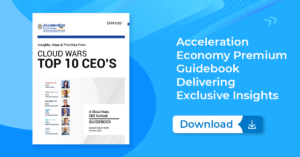
Overshadowing some strong Q2 cloud results, SAP CEO Christian Klein said customers wanting access to the company’s large and fast-growing Business AI portfolio must pay a 30% premium and enroll in the RISE or GROW programs.
This is a bold display of leadership by Klein as it gives SAP first-mover status among the leading cloud vendors in setting a new pricing model for a new wave of generative AI technologies that have captured the imagination of both the business world and the consumer world.
It is also a move that conveys more than a little risk for SAP as it seeks to shed the last vestiges of its long and storied on-premises past and emerge as a cloud-first company that blends cutting-edge innovation with enormous scale and industry expertise.
The risk is complicated in its workings but simple in nature: at a time when many customers across the globe are clamping down on expenditures, SAP is telling them that they can have full access to the extraordinary power of GenAI software only if they pony up what Klein called a 30% “uplift.”
But leaders don’t become leaders by doing what everyone else does, and I give SAP a lot of credit for claiming the first-mover mantle and declaring with great confidence that customers will be willing to pay that premium because the business innovations they will receive in return are so valuable.
Because this is such a seminal moment for the entire Cloud Wars Top 10 — how do you price the keys to the future? — I feel it’s important to share Klein’s thinking. So I’m going to run a detailed excerpt from the earnings call in which he explains the power of SAP Business AI and then reveals how the price of poker has just gone up.
Gain insight into the way Bob Evans builds and updates the Cloud Wars Top 10 ranking, as well as how C-suite executives use the list to inform strategic cloud purchase decisions. That’s available exclusively through the Acceleration Economy Cloud Wars Top 10 Course.
“As I said earlier, we believe we are uniquely placed to become the leader in AI built for business,” Klein said. “Customers will benefit from new AI-powered solutions that step-change how processes can self-learn and self-automate to optimize business outcomes. For example, imagine supply chains that automatically initiate a different delivery route based on weather and congestion data.
“There will be a step-change in how employees can interact with solutions in radically more efficient and personalized ways. For instance, imagine your ERP system using embedded ESG data and business data to decarbonize the supply chain by 5% simply by asking for it, and there will be a step-change in uncovering new insights that lead to better business decisions. Imagine one trusted data layer across your entire company that enables AI to pull together the right data in seconds,” Klein said.
And then he attempts to quantify the opportunity for SAP — a doubling of its addressable market to $1 trillion — and also the remarkable new levels of business value for customers.
“This will bring us significant opportunities for market expansion through new AI-based solutions and new premium offerings. Based on external forecasts and our own calculations, we see a potential doubling of our addressable market to $1 trillion by 2028 with AI being a key contributor,” Klein said.
“We will be introducing new premium RISE offerings with an uplift of up to 30% in the fall. Our approach with SAP Business AI is unmatched in the industry, delivering our customers the most relevant, reliable and responsible AI for business.”
Examples of Generative AI-powered Business Innovation
In the Q&A portion of the call, Klein elaborated on why he feels the 30% premium that customers will pay is a fair price for the innovation they’ll get.
“We have today about 300 AI use cases. And for example, take Calphalon: they actually have massive demand-forecast data with over 400 input levels going into the demand forecast. We are taking all this data — petabytes of data — and analyzing it to better predict demand. Now they can actually optimize their inventory and reduce their supply-chain costs by over 10%, which is massive for a company of their size and scale,” Klein said.
He went on to describe other examples:
- Scenarios for cash-flow automation that cut DSO (days sales outstanding) by 10%
- The ability to instantly analyze data from 400,000 customers to optimize business-policy recommendations
- Helping on-prem customers with heavily customized ERP systems generate clean, modern code in the cloud to rapidly build differentiating capabilities
- Addressing skills gaps by analyzing which countries and which universities have generated the best skills in the past
For that level of innovation, Klein went on to say, a 30% premium is a fair exchange.
“This is what SAP can do, and this is where we can launch further innovative AI use cases. They will come with a 30% premium, because we believe in the immense value and we see how customers respond to that. And we are going to embed that in every RISE deal going forward.”
Carrots and Sticks
Under Klein’s leadership, SAP has been quite clear about its desire to have its on-prem customers move ambitiously to the cloud because that’s the only way those customers will be able to boost their levels of performance to match the ever-increasing expectations of customers, whether consumers or businesses.
So SAP is adopting a very precise approach to its generative AI treasures: move to the cloud with RISE, or you don’t get the generative AI opportunity.
“We are not offering Generative AI sustainability capabilities and also quite different trading capabilities in our LOB products and on-prem,” he said in response to an analyst’s question.
“And also, when a customer decides to go to a hyperscaler and get hosted with still more customizations and not-aligned data models and doing this outside of RISE, then this offering is not available. We cannot apply AI with high quality without high data quality and that’s hard to achieve in a highly customized ERP on-premise system, and that is why AI is only available in the cloud. That’s very, very important.”
Indeed it is — for both the customer and for SAP.
“Demand Level Is Very High”
Supporting Klein’s perspective, the head of SAP’s global sales and customer-success organization, executive board member Scott Russell, said that as customers see how generative AI can accelerate and optimize their highly strategic business transformations, they will be open to expanding their RISE-based relationships with SAP.
“I want to reiterate what Christian mentioned in the beginning: digital transformation and the demand for the digital change in their core businesses for customers around the world continues unchanged,” Russell said. “The demand level is very high. And we definitely see that across all parts of the world in the regional performance with RISE.
“We’ve now got a large set of customers that were the early movers that have now successfully transformed and are operating as our proof points in that success journey. Part of that digital transformation is to be able to drive value and early return on that investment and that’s where the AI becomes an accelerator,” Russell said.
“So while there are definitely parts of the market where there’s a level of prudence in terms of the return on investment and making sure these digital programs are delivering the outcomes, the use of AI embedded into our processes and technology is one of the factors that is driving the strong demand that we continue to see.”
Final Thought
Christian Klein has not transformed SAP into a high-growth cloud powerhouse by being tentative and cautious. Rather, he’s taken a number of calculated risks based on customers’ evolving needs and expectations.
Will some balk at the 30% premium for AI? No question.
Will those balkers remain competitive? I would say that’s a huge question.
I applaud Klein for making this decision because it’s based not on SAP’s internal cost structure but rather on how customers perceive value, innovation, and risk — particularly the risk of standing still in a world where the future’s coming at us faster than ever before.










